airbag CITROEN DS3 CABRIO DAG 2015 Handbook (in English)
[x] Cancel search | Manufacturer: CITROEN, Model Year: 2015, Model line: DS3 CABRIO DAG, Model: CITROEN DS3 CABRIO DAG 2015Pages: 404, PDF Size: 13.93 MB
Page 6 of 404
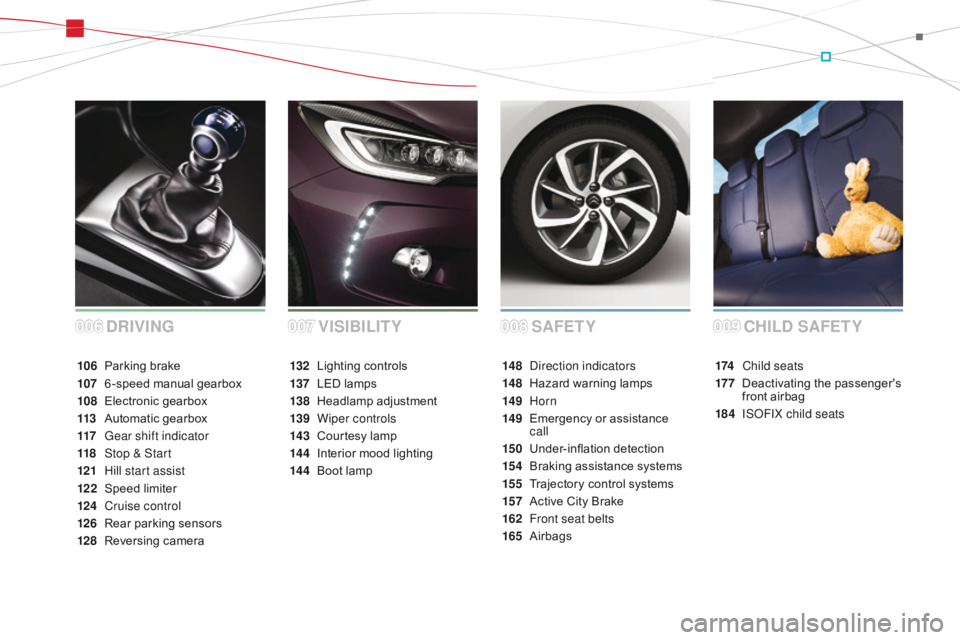
DS3_en_Chap00a_sommaire_ed01-2014
SAFETYdR
IVINGc HILd S AFETY
174 Child seats
17 7
D
eactivating
t
he
p
assenger's
f
ront airbag
184
I
S
oF
IX child seats
14 8 D
irection indicators
14 8
H
azard
w
arning
lam
ps
14 9
Horn
14 9
E
mergency
or
assistance
c
all
15 0
U
nder-inflation
d
etection
15 4
B
raking
assistance
systems
155
T
rajectory
control
systems
157
A
ctive
City
Brake
162
F
ront seat belts
165
A
irbags
132 L
ighting c
ontrols
137
L
ED
lamps
138
H
eadlamp
adj
ustment
139
W
iper controls
14 3
C
ourtesy
lamp
14 4
I
nterior
m
ood
l
ighting
14 4
B
oot
lamp
106 P
arking
brake
107
6
-speed
m
anual
g
earbox
108
E
lectronic
g
earbox
113
A
utomatic
gearbox
117
G
ear shift indicator
118
St
op & Start
121
H
ill start assist
122
Spe
ed
l
imiter
124
C
ruise control
126
R
ear
parking
sensors
128
R
eversing
c
amera
008009006007 VISIBILITY
Page 14 of 404

DS3_en_Chap00b_vue-ensemble_ed01-2014
Instruments and controls
1. Steering lock and ignition.
2. A udio equipment steering wheel controls.
3.
W
iper / screenwash / trip computer stalk.
4.
S
cented air freshener.
5.
C
entral locking switch.
6.
M
ultifunction
s
creen.
7.
H
azard warning lamp switch.
8.
C
entral adjustable air vents.
9.
S
unshine sensor
H
i-Fi audio system central speaker.
10.
P
assenger's
ai
rbag.
11.
S
ide adjustable air vent.
12 .
G
love box / Passenger's airbag
d
eactivation.
13.
P
arking brake.
14 .
C
entral armrest with storage.
15.
U
pper and lower storage.
16.
A
udio system or eMyWay.
17.
H
eating / air conditioning controls.
Page 24 of 404

DS3_en_Chap01_controle-de-marche_ed01-2014
Visual indicators informing the driver that a system is in operation (operation
o
r deactivation indicator lamps) or of the
o
ccurrence of a fault (warning lamp).
Indicator and warning lamps
Associated warnings
The illumination of certain warning lamps may be accompanied by an audible signal and a
m
essage in the multifunction screen.
The
warning lamps may come on
c
ontinuously (fixed) or flash.
Certain
warning lamps may come
o
n in two different modes. Only by
r
elating the type of lighting to the
o
perating status of the vehicle can it
b
e ascertained whether the situation is
normal
or whether a fault has occurred.
If
they
remain
on,
before
moving
off,
r
efer
to
the
information
on
the
warning
lam
p
c
oncerned.
The
passenger's
airbag
system
o
peration
lamp
stays
on
for
about
a
m
inute
after
switching
on
the
ignition,
e
ven
after
the
engine
has
started.
When the ignition is switched on
Certain warning lamps come on for a few s econds when the vehicle's ignition is
switched
on.
When
the engine is started, these same
w
arning lamps should go off.
Page 28 of 404

DS3_en_Chap01_controle-de-marche_ed01-2014
deactivation indicator lamps
If one of the following indicator lamps comes on, this confirms that the corresponding system has been switched off intentionally.
T his is may be accompanied by an audible signal and a message on the multifunction screen.
Warning lamp is on
cau
seAction / Observations
Passenger's
airbag system fixed.
The
control, located in the glove box,
i
s set to the OFF
p
osition.
The
passenger's front airbag is
d
eactivated.
You
can install a "rear ward facing"
c
hild seat, unless there is a fault with
the
operation of the airbags (Airbag
w
arning lamp on).Set the control to the ON
position to activate the
passenger's
front airbag.
In this case, do not fit a child seat in the rear ward
facing
position.
Page 33 of 404

31
DS3_en_Chap01_controle-de-marche_ed01-2014
Airbagstemporarily. This lamp comes on for a few seconds w
hen you turn on the ignition, then
g
oes off.This
lamp should go off when the engine is started.
If it does not go off, contact a CITROËN dealer or a
q
ualified
w
orkshop.
fixed. One
of the airbag or seat belt
p
retensioner systems has a fault.Have
it checked by a CITROËN dealer or a qualified
w
orkshop.
Warning lamp
is on
cau
se
Action / Observations
Seat belt not
fastened /
unfastened fixed
then flashing
a
ccompanied by an
inc
reasing
a
udible
s
ignal. The
driver and/or the front passenger
h
as not fastened or has unfastened
their
seat belt.Pull
the strap then insert the tongue in the buckle.
Power steering fixed. The
power steering has a fault. Drive carefully at reduced speed.
Have
it checked by a CITROËN dealer or a qualified
w
orkshop.
Monitoring
Page 101 of 404
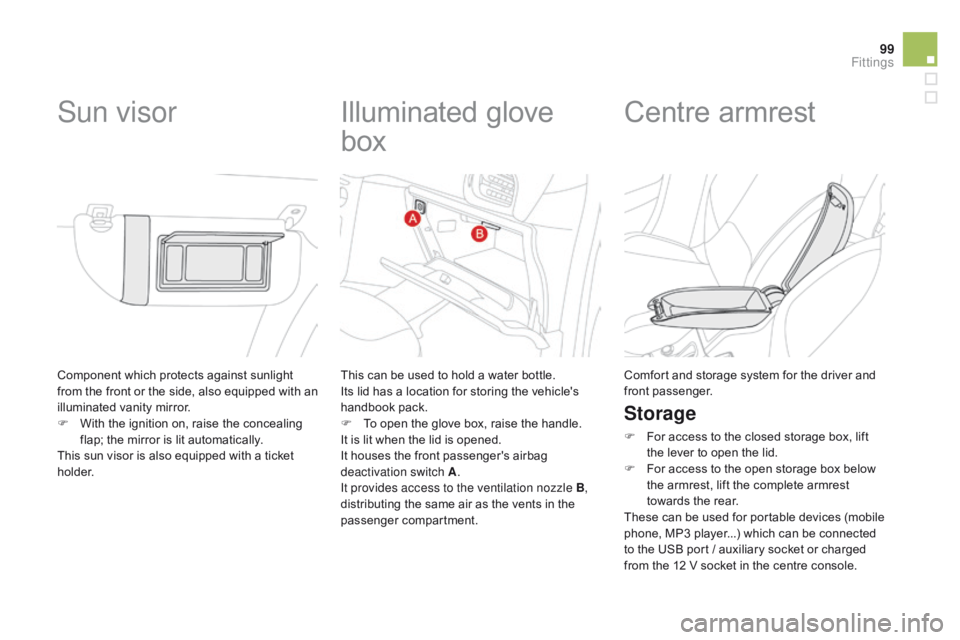
99
DS3_en_Chap05_amenagement_ed01
Component which protects against sunlight from t he f ront o r t he s ide, a lso e quipped w ith a n
i
lluminated
v
anity
m
irror.
F
W
ith the ignition on, raise the concealing
f
lap; the mirror is lit automatically.
This
sun visor is also equipped with a ticket
h
o l d e r.
Sun visor Illuminated g love
b
ox
This can be used to hold a water bottle.
I ts lid has a location for storing the vehicle's
han
dbook
pa
ck.
F
T
o open the glove box, raise the handle.
It
is lit when the lid is opened.
It
houses the front passenger's airbag
d
eactivation switch A .
It provides access to the ventilation nozzle B ,
distributing
the same air as the vents in the
p
assenger
c
ompartment.
Centre armrest
Storage
F For access to the closed storage box, lift t
he lever to open the lid.
F
F
or access to the open storage box below
t
he armrest, lift the complete armrest
t
owards the rear.
These
can be used for portable devices (mobile
p
hone, MP3 player...) which can be connected
t
o the USB port / auxiliary socket or charged
f
rom the 12 V socket in the centre console.
Comfort
and storage system for the driver and
f
ront
p
assenger.
Fittings
Page 148 of 404
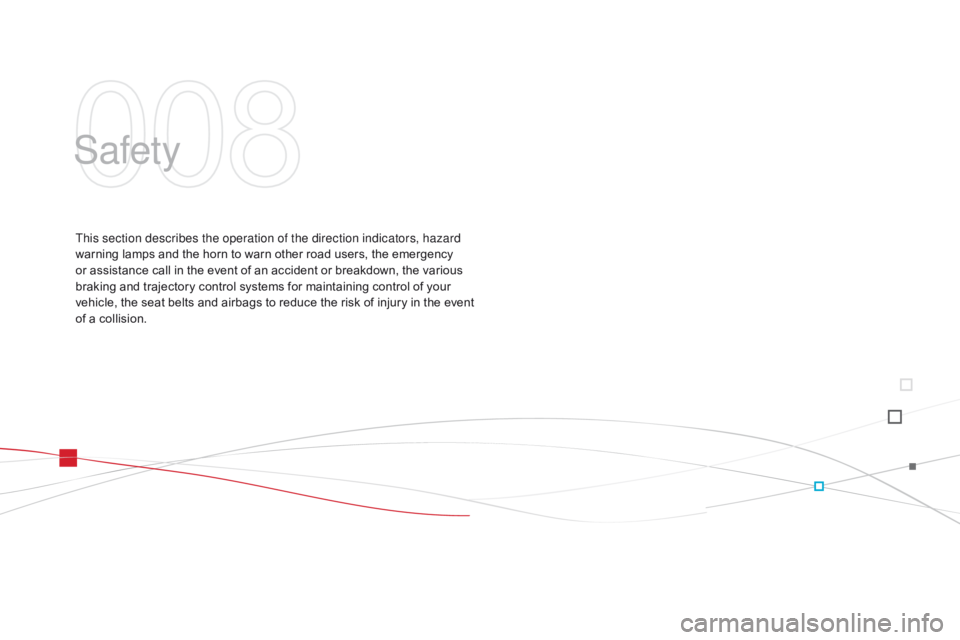
Safety
This section describes the operation of the direction indicators, hazard
warning lamps and the horn to warn other road users, the emergency
o
r assistance call in the event of an accident or breakdown, the various
b
raking and trajectory control systems for maintaining control of your
v
ehicle, the seat belts and airbags to reduce the risk of injury in the event
o
f a collision.
Page 166 of 404
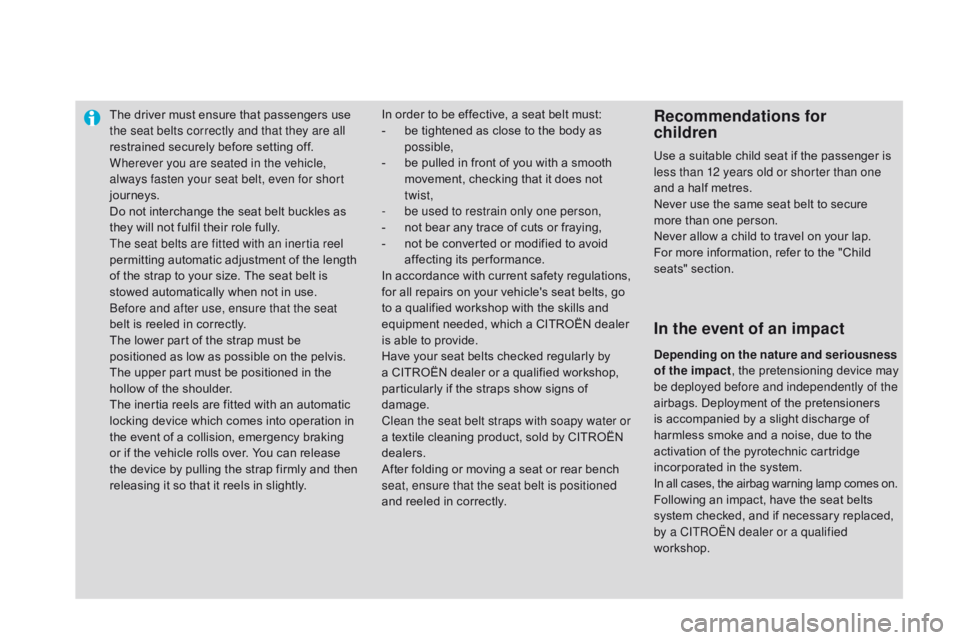
The driver must ensure that passengers use the seat belts correctly and that they are all
restrained
securely before setting off.
Wherever you are seated in the vehicle,
always fasten your seat belt, even for short
journeys.
Do
not interchange the seat belt buckles as
t
hey will not fulfil their role fully.
The seat belts are fitted with an inertia reel
permitting
automatic adjustment of the length
o
f the strap to your size. The seat belt is
s
towed automatically when not in use.
be
fore and after use, ensure that the seat
belt
is reeled in correctly.
The
lower part of the strap must be
p
ositioned as low as possible on the pelvis.
The
upper part must be positioned in the
h
ollow of the shoulder.
The
inertia reels are fitted with an automatic
l
ocking device which comes into operation in
t
he event of a collision, emergency braking
o
r if the vehicle rolls over. You can release
t
he device by pulling the strap firmly and then
r
eleasing it so that it reels in slightly.In
order to be effective, a seat belt must:
- b e tightened as close to the body as
p
ossible,
-
b
e pulled in front of you with a smooth
m
ovement, checking that it does not
t
wist,
-
b
e used to restrain only one person,
-
n
ot bear any trace of cuts or fraying,
-
n
ot be converted or modified to avoid
a
ffecting
it
s
p
erformance.
In
a
ccordance
w
ith
c
urrent
s
afety
r
egulations,
f
or all repairs on your vehicle's seat belts, go
t
o a qualified workshop with the skills and
e
quipment needed, which a CITROËN dealer
i
s able to provide.
Have
your seat belts checked regularly by
a
CITROËN dealer or a qualified workshop,
p
articularly if the straps show signs of
d
amage.
Clean the seat belt straps with soapy water or
a
textile cleaning product, sold by CITROËN
d
ealers.
After
folding or moving a seat or rear bench
s
eat, ensure that the seat belt is positioned
and
reeled in correctly.Recommendations for
children
Use a suitable child seat if the passenger is less than 12 years old or shorter than one
and
a half metres.
Never
use the same seat belt to secure
m
ore than one person.
Never
allow a child to travel on your lap.
For
more information, refer to the "Child
sea
ts"
se
ction.
In the event of an impact
depending on the nature and seriousness
of the impact ,
the pretensioning device may
b
e deployed before and independently of the
airbags.
Deployment of the pretensioners
i
s accompanied by a slight discharge of
h
armless smoke and a noise, due to the
a
ctivation of the pyrotechnic cartridge
i
ncorporated in the system.
In
all cases, the airbag warning lamp comes on.
Following
an impact, have the seat belts
s
ystem checked, and if necessary replaced,
b
y a CITR
oË
N dealer or a qualified
workshop.
Page 167 of 404
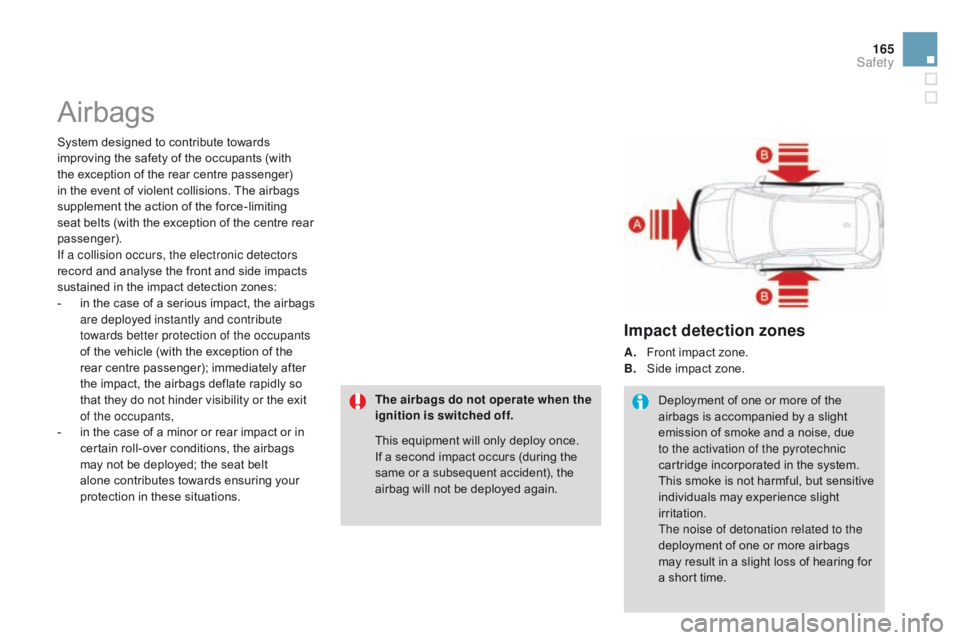
165
DS3_en_Chap08_securite_ed01-2014
Airbags
System designed to contribute towards improving the safety of the occupants (with
t
he exception of the rear centre passenger)
i
n the event of violent collisions. The airbags
s
upplement the action of the force-limiting
s
eat belts (with the exception of the centre rear
p
assenger).
If a collision occurs, the electronic detectors
record
and analyse the front and side impacts
s
ustained in the impact detection zones:
-
i
n the case of a serious impact, the airbags
a
re deployed instantly and contribute
towards better protection of the occupants
of
the vehicle (with the exception of the
r
ear centre passenger); immediately after
t
he impact, the airbags deflate rapidly so
t
hat they do not hinder visibility or the exit
o
f the occupants,
-
i
n the case of a minor or rear impact or in
c
ertain roll-over conditions, the airbags
m
ay not be deployed; the seat belt
a
lone contributes towards ensuring your
p
rotection in these situations. This
equipment will only deploy once.
I
f a second impact occurs (during the
s
ame or a subsequent accident), the
a
irbag will not be deployed again.
Impact detection zones
A. Front impact zone.
B. S ide impact zone.
Deployment
of one or more of the
a
irbags is accompanied by a slight
e
mission of smoke and a noise, due
t
o the activation of the pyrotechnic
cartridge
incorporated in the system.
This
smoke is not harmful, but sensitive
i
ndividuals may experience slight
ir
ritation.
The noise of detonation related to the
deployment
of one or more airbags
m
ay result in a slight loss of hearing for
a
short time.
The airbags do not operate when the
ignition is switched off.
Safety
Page 168 of 404
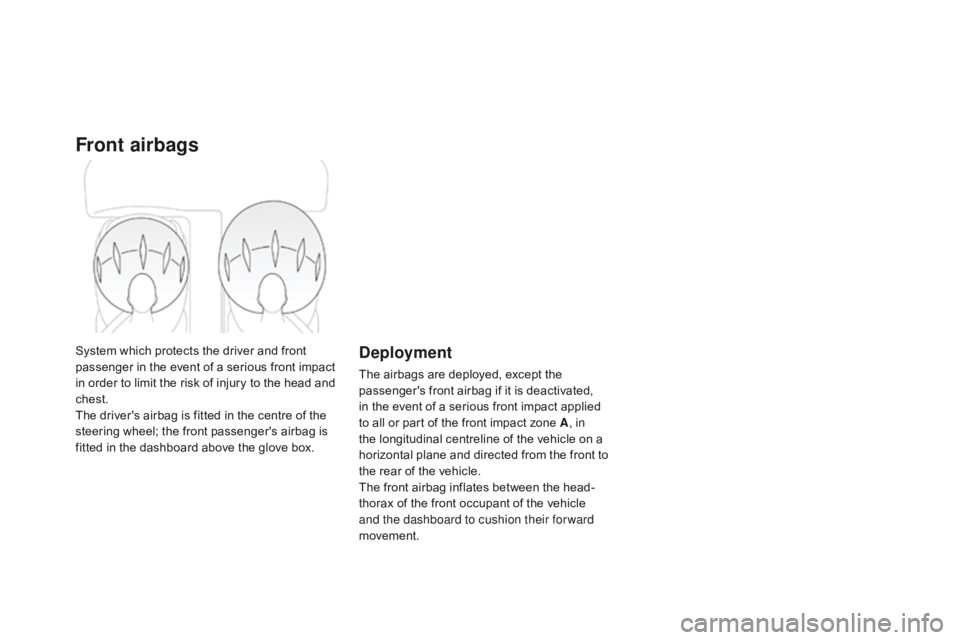
Front airbags
System which protects the driver and front passenger in the event of a serious front impact
i
n order to limit the risk of injury to the head and
c
hest.
The
driver's airbag is fitted in the centre of the
s
teering wheel; the front passenger's airbag is
f
itted in the dashboard above the glove box.deployment
The airbags are deployed, except the passenger's front airbag if it is deactivated,
i
n the event of a serious front impact applied
t
o all or part of the front impact zone A, in
the
longitudinal centreline of the vehicle on a
h
orizontal plane and directed from the front to
t
he rear of the vehicle.
The
front airbag inflates between the head-
thorax
of the front occupant of the vehicle
an
d the dashboard to cushion their forward
movement.